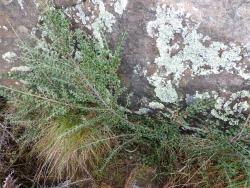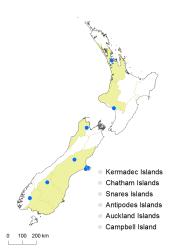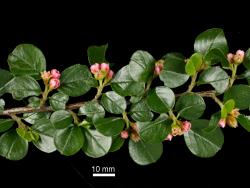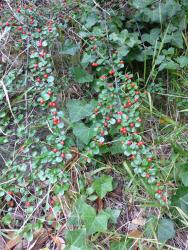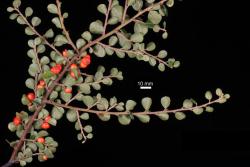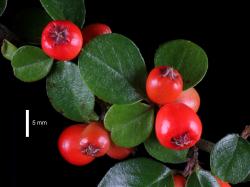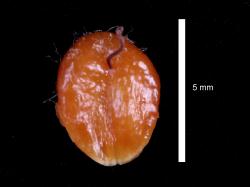Low shrub with spreading branches, up to 0.6(1.5) m tall, deciduous. Branches in flattened planes; branchlets red-brown to grey-brown, branchlet hairs moderately dense to dense, yellow; stipule 1.8–4.0 mm long, usually red, hairs absent or sparse. Leaves crowded on branches, 16–29 mm long, lamina 14–23 mm long, 10–17 mm wide, elliptic or orbicular, plane or V-shaped in cross-section, or slightly cupped, 160–310 µm thick, petiole 1.5–6 mm long, with sparse to moderately dense, straight, pale yellow hairs, leaf base cuneate, obtuse or rounded; leaf apex round, apiculus cuspidate or apiculate; lateral veins in 2–5 pairs, midvein or midvein and lower lateral veins impressed above and projecting below; upper surface smooth, moderate olive green (RHS 137B), glossy, upper-surface hairs absent or sparse, yellow, straight; margins plane, hairs absent or sparse and yellow; lower surface glossy, hairs sparse, pale yellow, straight (strigose).
Inflorescence a corymb of 1–4 flowers 7–11 mm long, rachis hairs moderately dense, yellow; pedicel 0–1.0 mm long, hairs absent to dense. Flowers 3.3–4.2 mm diameter. Hypanthium green, sepals 1.1–1.5 mm long, 2.0–2.4 mm wide, hairs absent to sparse, yellow. Petals red in bud, erect when flower open, red at outer base, pink inside and at margins, 3.1–3.8 mm long, 2.5–3.2 mm wide, base clawed or not, tuft of hairs absent, margins irregular. Stamens 12–15(17); filaments 1.6–2.0 mm long, dark pink; anthers white, 0.8–1.0 mm long; styles 2–3(4), 1.5–2.0 mm long. Fruit vivid red (RHS 44A), obovoid, 6.0–8.5 mm long, 6.1–9.0 mm diameter, calyx closed or open, hairs very sparse to absent. Pyrenes 2–3(4), 3.6–5.5 mm long, 2.1–4.4 mm wide, hairs sparse to moderately dense at apex, umbonate, style attached 1.2–2.1 mm below pyrene apex.
Procumbent low-growing shrub with branches forming a herringbone pattern. Deciduous. Leaf lamina 14–23 mm long, elliptical with acute to cuspidate apices, midvein impressed on upper surface, leaf usually slightly but distinctly V-shaped, margins not contorted or recurved, lower surface not glaucous. Flowers 1 or 2. Petals erect, dark red at centre, dark pink at the petal margins. Stamens 12, filaments dark red, anthers white. Fruit with (2)3(4) pyrenes, the style attached below the pyrene apex.
Most similar to Cotoneaster perpusillus. Both are low-growing, prostrate, or cascading, both have secondary branches regularly distichous; both have leaves glossy on the upper surface, the lower surface not glaucous, with sparse, straight, thick hairs; the flowers of both have petals erect and red centrally, pink at the margins, stamens are few with filaments red and anthers white. Cotoneaster horizontalis has larger leaves (lamina 14–23 mm long rather 10–14 mm); stamens 11–17, not 8–11, and fruit larger, 6–10 mm diameter, not c. 6 mm diameter.
Auckland (Mt Hobson, 1994), Southern North Island (Whanganui, 2007), Western Nelson (South Graham R, 1993), Canterbury (Hilltop, 1988; Birdlings Flat, 2007; Rāpaki, 2016; Castle Hill village, 2013), Otago (Lake Hāwea, 2001), Southland (Lake Manapōuri, 1997). Fairly common in cultivation.
CHR 498374, Banks Peninsula, Hilltop on Barrys Bay side, H.D. Wilson BP1392, 3 Dec. 1988, "single plant, wild".
Flowering: late September to November; Fruiting: December to May, persisting over winter
Tetraploid (Fryer & Hylmö 2009)



